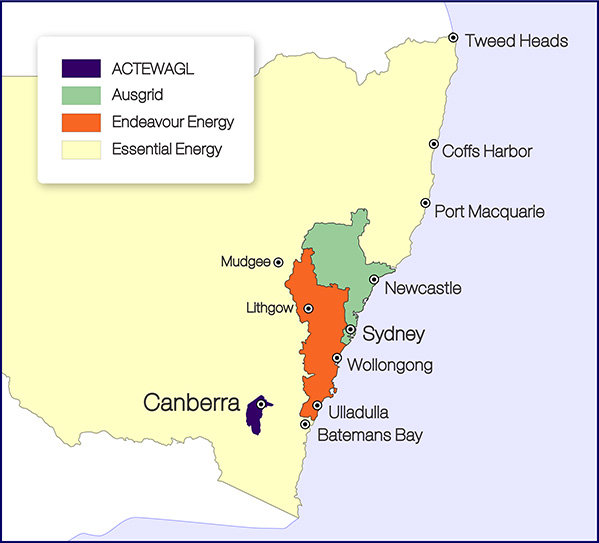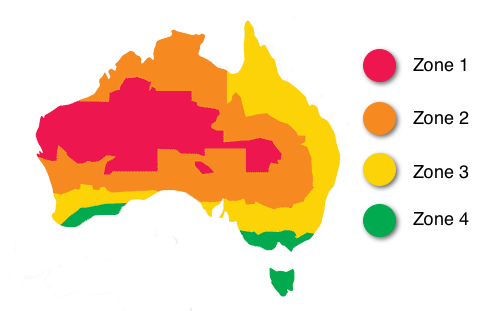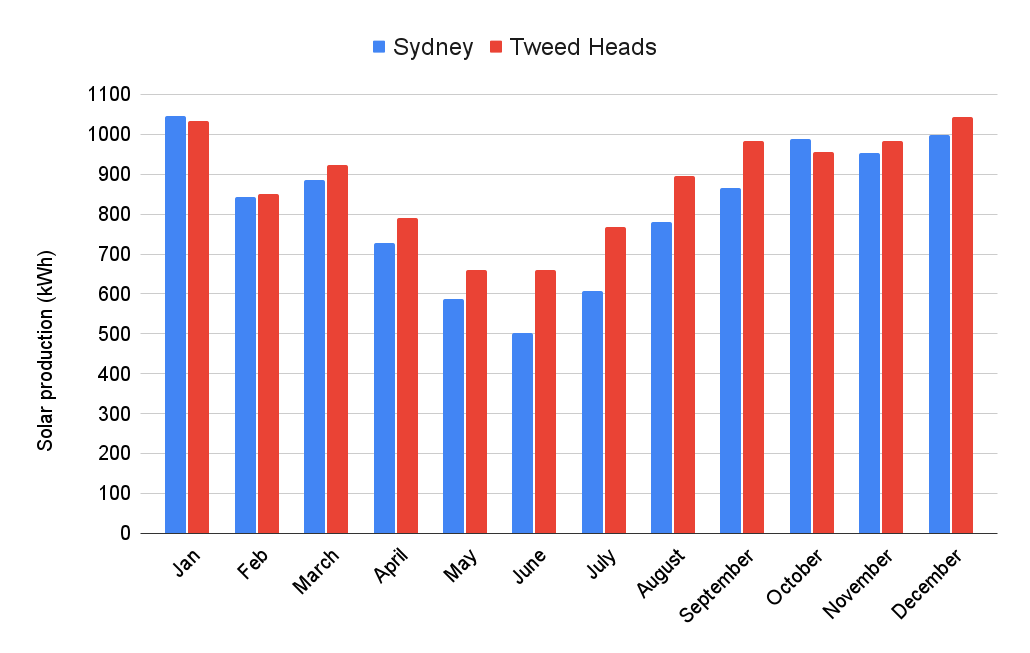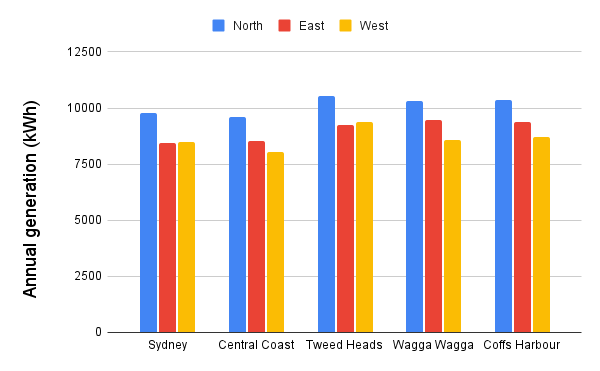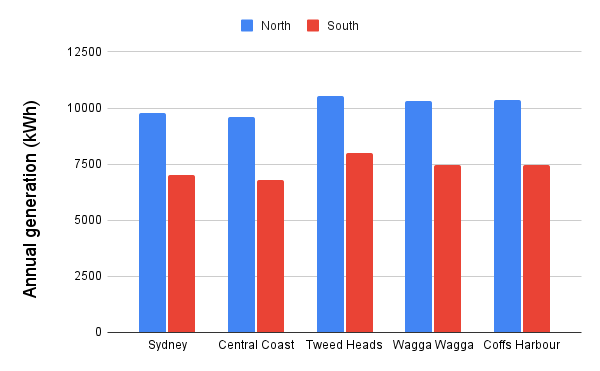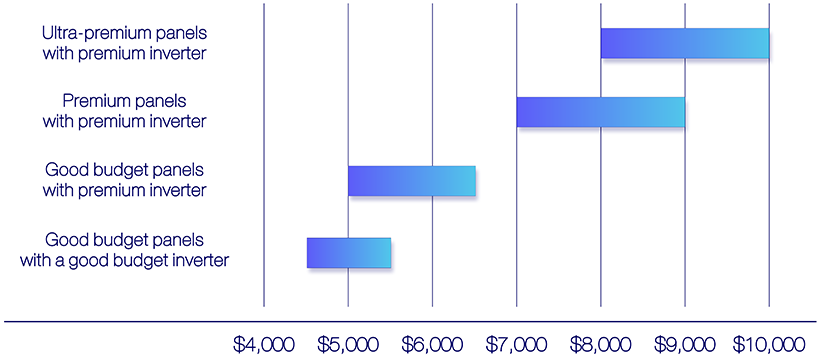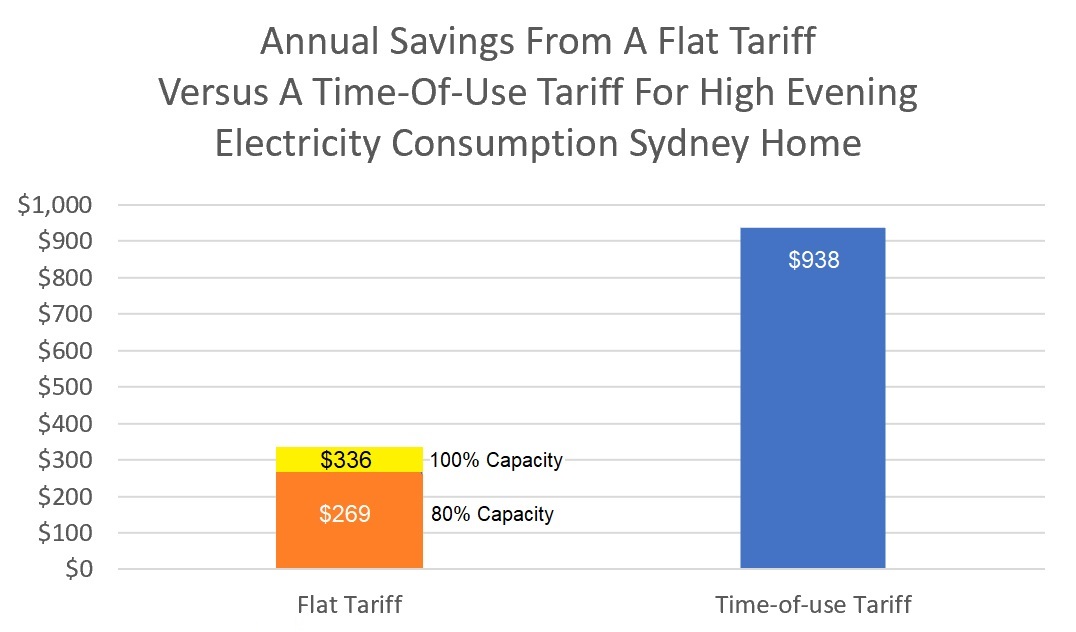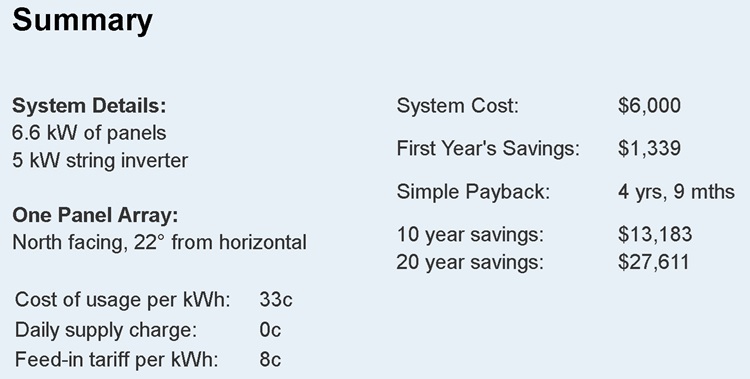Solar ‘101’ – New South Wales Edition
By Finn Peacock – Chartered Electrical Engineer, Ex-CSIRO, Founder of SolarQuotes.com.au
This 101 guide covers what you need to think about when going solar in New South Wales. It accompanies my more broad “Solar 101” beginners guide, which has helped well over 100,000 Australians install panels with confidence.
New South Wales has three electricity distribution networks (called DNSPs):
- Essential Energy (servicing regional NSW)
- Ausgrid (servicing east Sydney and areas north of it, including Newcastle.)
- Endeavour Energy (servicing greater western Sydney from Paramatta to the Blue Mountains and areas south of Sydney including Wollongong.)
When you buy a solar power system, you need to be aware of any local details – many of which depend on who your DNSP is. So, if you’re living in New South Wales – this guide is for you.
- The good – and bad – of solar in New South Wales
- Solar rebates in New South Wales
- Winter generation and energy use habits
- How panel direction affects solar energy production in NSW
- Costs for solar power in New South Wales
- Solar systems (and exports) can be large
- Who’s the best electricity retailer in New South Wales?
- What’s the best electricity tariff for a solar home?
- Batteries don’t pay for themselves – unless you’re going off-grid
- How long will solar power take to pay for itself in NSW?
The good – and bad – of solar in New South Wales.
New South Wales is a great place for solar energy, with Ausgrid having the most “solar friendly” distribution network.
The good
- Single-phase homes in the Ausgrid network area (most of NSW, population-wise) can install a large 13.3 kW solar system with no export limitation. Most DNSPs have a 5 kW export limit per phase.
- Ausgrid does a lot of random audits of systems – especially battery installs. This is extra peace of mind for consumers, as it keeps installers on their toes.
- Essential Energy and Endeavour Energy don’t count AC coupled batteries towards your inverter phase limit, which means it’s much more straightforward to install a battery on your home if you have a larger solar system.
- There are many installers operating in New South Wales. This means there’s a lot of competition – and very competitive prices for consumers.
- On November 1st 2024, the NSW government introduced a battery rebate.
The bad
- The downside to New South Wales being a competitive market for installing solar power means there can be a race to the bottom for solar pricing in many areas. The problem in joining the race to the bottom is that you might just win. If you buy the cheapest solar system advertised, don’t expect decades of low bills and high performance. Look for a fair price from an excellent, local installer.
- If you’re located in the Essential network area (rural NSW) and live on a shared (strata) property, your export limit is divided by the number of properties in the strata. If you are in a group of 5 homes, each home may only be allowed 1kW export.
Solar rebates in New South Wales
The real name of the ‘solar rebate‘ is the “Small-Scale Renewable Energy Scheme (SRES)”. It’s a mouthful – you can see why everyone calls it ‘the rebate’.
The scheme is designed so that when you install solar panels, ‘STCs’ – pieces of virtual paper – are generated. The larger the solar system, the more STCs you generate. You sign over the right to these STCs to your installer, who bundles them up and trades them for cash. They pass on the value of the STCs to you as a point of sale discount. It’s already included in the advertised or quoted price.
The value of STCs depends on the zone in which they’re generated. Zone 1 has the highest value, and zone 4 has the lowest:
Pro-tip: Most of Australia lives in zone 3
Most of the state lives on or near the coast, which is zone 3. Inner-regional areas of New South Wales are a part of zone 2.
To demonstrate the difference in rebate between the two zones – if someone located in Newcastle (zone 3) were to buy a 6.6 kW solar power system, it would attract about $2,300 worth of rebate.
If someone in Bourke (zone 2) were to buy the same 6.6 kW system, their rebate would be worth around $2,500.
Winter generation and energy use habits
Most cities in New South Wales generate about half the amount of energy in the depths of winter as they do at the height of summer. But the overall pleasant climate of most of the state means you’ll need less heating to keep things comfortable than in Victoria.
The further north you go, the smaller the difference between summer and winter solar energy generation. Compare the annual generation of a 6.6 kW solar system in Sydney to one in Tweed Heads:
So the further north you are in New South Wales, the less careful you need to be about your electricity usage in the winter, as your solar panels will be able to offset a good amount of it.
The further south you are in the state, the more solar you’ll need to install to have enough generation to run energy-hungry appliances such as heaters and conventional electric hot water systems in winter.
The generous system size allowances from Ausgrid (10 kW inverter capacity per phase with no export limit) mean there is a strong financial incentive to go as large as possible.
How solar panel direction affects energy production in NSW
My main Solar 101 guide mentioned that north is the optimal direction to face your panels for the highest solar generation possible. East and west facing panels won’t produce as much energy overall, but ones facing east can be an advantage for homes with high morning electricity consumption, while west facing ones for the majority of homes that have high electricity consumption late in the day.
So, just how much generation will you lose if you face your panels west or east?
This graph shows the annual production of east or west-facing panels, compared to north-facing, in major New South Wales towns/cities.
Even south-facing panels can generate a respectable amount of energy: generating around 29% less energy overall than ‘ideal’ north-facing panels:
The typical north-facing $6,000 6.6 kW system in New South Wales has a payback of under 5 years. For a south-facing 6.6 kW system, this payback stretches out to around 5 years, 6 months – which is still well worth it for most people.
Pro-tip: If you want to squeeze every last drop of energy out of your panels, face them slightly north-north-east.
Costs for solar power in New South Wales – and brands to trust
Here’s what you can expect to pay for a 6.6 kW solar system in a major metro area in NSW:
If your roof is quite hard to work with – multiple roof angles/directions, scissor lift access required, etc. – anticipate paying more than these price ranges.
For those of you living in a more regional area – expect to pay around a 20% premium over these prices.
Pro-tip: You’ll find some companies offering jaw-droppingly low prices – below what I’ve mentioned here. Avoid these systems – when you buy cheap, you buy twice.
Brands to trust
Taken from my main solar 101 guide, I’d be happy to have any of these brands on my own home:
Recommended Solar Panels

Recommended Solar Inverters

I wouldn’t expect any particular brand to perform better than another in ‘New South Wales conditions’ – so don’t listen to any salesman’s hype.
Solar systems (and exports) can be large
There are three major Distributed Network Service Providers (DNSPs) servicing New South Wales: Ausgrid, Endeavour Energy and Essential Energy.
Here are the solar system sizing rules for each:
Ausgrid
- Single-phase: 10 kW inverter limit, 10 kW export limit.
- Three-phase: 30 kW inverter limit, 30 kW export limit.
- Ausgrid “may” count battery inverters towards phase inverter limit.
Endeavour Energy
- Single-phase: 10 kW inverter limit, 5 kW export limit.
- Three-phase: 30 kW inverter limit, 30 kW export limit.
- Battery inverters do not count towards phase inverter limit.
Essential Energy
- Single-phase: 5 kW inverter limit, 5 kW export limit.
- Three-phase: 15 kW inverter limit, 15 kW export limit.
- Rural areas: 3 kW inverter/export limit per phase.
- Battery inverters do not count towards phase inverter limit.
A note on Essential Energy – we’ve heard feedback from our clients operating in the Essential network area that they’re starting to crack down hard on export limits, even for three-phase properties.
On paper, they allow a 15kW inverter/export limit for a three-phase property. Installers have told me that it’s becoming more common for Essential to restrict systems to a 5 kW export limit total.
We’ve also heard of a new rule classifying strata properties as ‘one’ for export limitation reasons – so if you’re in a group of 5 homes, each home will only be allowed a 1 kW export limit.
Note that you’re allowed to ‘oversize’ the wattage of panels on your roof by 133% of your inverter capacity. So, you can have up to 13.3 kW (10 kW inverter limit x 133%) of panels on a single-phase home.
‘Battery inverters counting towards the inverter limit’ means if you want to ‘AC Couple‘ a battery, your solar system can’t be too big. For example, if you have a single-phase home with an 8 kW inverter and 10 kW of panels, Ausgrid may not allow you to add a Tesla Powerwall 2 with a 5 kW battery inverter inside it. This is because 8 + 5 = 13 kW total.
Many of our clients have told us they’ve had minimal problems getting Ausgrid to approve scenarios like the one just described – but it’s important to be aware that they can potentially knock back your application.
Pro-tip: Export limits affect your savings less than you might expect.
Who’s the best electricity retailer in New South Wales?
New South Wales is a competitive market for solar installers, which means it’s a competitive market for energy retailers.
At the time of writing, more than 20 retailers are servicing New South Wales – so consumers are spoilt for choice and shouldn’t find it hard to shop around for a better deal on their electricity.
Our nifty Electricity Retailer Comparison Tool will tell you what each retailer is offering in your postcode.
As an example – the difference in annual bill for a typical 8 kW system owner near Newcastle between the best and the worst plans available is about $1,000 per year. So it pays to shop around.
Not all retailers service all parts of NSW, so check your postcode in the tool.
My recommendation is to check my tool annually for the best deal. Then contact your existing retailer and ask them to match it. Often they will. If they won’t then just switch.
What’s the best electricity tariff for a solar home?
There are two main types of tariffs – time of use tariffs and ‘flat’ tariffs.
A flat tariff is straightforward – you have one price for your electricity, no matter what.
A time of use tariff charges you different per-kWh prices for electricity depending on the time of day and they’re increasingly common. You have a “peak”, “off-peak”, and “shoulder” period:
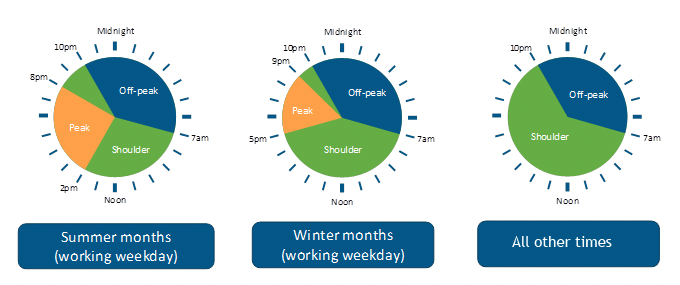
Time-of-use pricing periods, taken from Ausgrid’s website
The problem with time-of-use tariffs is they charge the most for electricity in the evenings, which is exactly when homes with solar panels are most likely to draw from the grid (because the sun is going down and their solar energy production is low). So they’re unlikely to make sense for a solar-only home.
But for solar + battery homes, they’re a no-brainer as a properly sized battery lets you ride through the peak period without drawing from the grid.
Compare the savings for a home in Sydney with a battery on a time-of-use tariff compared to a flat tariff:
Is the time right for battery storage?
Well,
Are you keen on new technology, want to protect yourself from blackouts, or support a new sustainable industry? Then go for it and buy a battery.
Is it imperative that the battery saves you money over its warranted life? For many households with typical electricity consumption, a home battery is not a great investment.
The one exception to this advice is if you’re in a rural area. Your DNSP may quote you $30,000 or more to have your property connected to the grid. In this situation, an off-grid solar and battery system can hold its own, price-wise, against having the grid built out.
The NSW government has introduced a new battery rebate, worth around $160 per kWh (capping out at 28 kWh), to help make batteries more affordable. If you join a VPP as well, you get around an extra $25 per kWh.
Pro-tip: Virtual Power Plants promise that they can increase the savings generated by a battery – but always check the fine print!
How long will solar (and batteries) take to pay for itself in NSW?
My solar calculator will answer this question:
Solar-only payback
Assuming:
- A 6.6 kW solar power system in Sydney, facing north, costing $6,000
- An unshaded roof
- An electricity usage tariff of 33 cents per kWh
- Feed-in tariff of 8 cents per kWh
- An annual electricity consumption of 4,500 kWh — close to the Sydney average
My calculator shows you’ll save $1,339 per year – so a simple payback period of 4 years, 9 months:
Pretty compelling.
Battery payback
Battery payback is more difficult to work out, but — provided your evening electricity consumption is high enough — they can pay for themselves relatively quickly, thanks to the NSW Battery Rebate.
If a household buys a Powerwall 2 with 13.5 kWh of battery storage, fully charges it with solar every day, and fully discharges it every evening during the peak period, it will save around $2,000 per year and — with the battery rebate — pay for itself in under 7 years.
But no household is likely to use a battery that way. One with a large solar system and a high evening electricity consumption may save around $1,500 — letting the battery pay for itself in around 9 years.
Homes with typical electricity consumption — even if they join a VPP — can have a payback period of over 15 years. As the maximum warranty period of most batteries is 10 years, it makes it hard to financially justify a battery for normal electricity consumption. But if a household places enough value on having backup power, they could still consider a battery worthwhile.
The next step
New South Wales is a great state for solar power. If you own an unshaded roof, I think you’re crazy if you put up with high electricity bills.
If you have any burning questions about the information in this guide, my contact details are:
Email: [email protected]
Tel: 08 7200 0177
If you’re in New South Wales and looking for quotes, SolarQuotes can help you get quotes from high quality, heavily vetted installers quickly and easily:
Happy Solar Power Hunting!
Finn Peacock, founder of SolarQuotes.com.au

